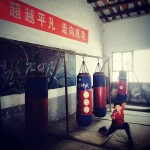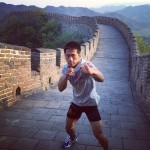(A condensed version of this story went up on Fightland)
When the Apocalypse goes down, I want guys like Moses Baca and Juan Quesada on my team. They’re both MMA fighters out of the renowned Cesar Gracie Academy in California, one of the sport’s legendary gyms, and both have years of training and fights behind them. Moses in particular is old school, having grown up and trained with the legendary Diaz brothers, Jake Shields and Gil Melendez during that team’s decade of dominance. That’s enough to give them a special place at the table. They make a great tandem: hard as nails Juan reborn again in martial arts, and soft spoken Moses, a BJJ black belt who loves to play with the kids.
Unfortunately, most of that was lost on their Chinese host. For Sichuan-based C3, the tiny provincial promotion that paid to bring them over, Juan and Moses were just warm foreign bodies, part of a big show for the people of Ya’an, a city at the foot of the Himalayas famous for good fish, pretty girls, and lots of rain.







